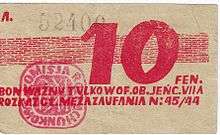Token money

In economics, Token money, or Token, is money that has little intrinsic value compared to its face value. Unlike fiat money, which also has little intrinsic value, it is limited legal tender.[1] It does not have free coinage.[2][3] More broadly token money typically represents the promise to be exchanged for something of value in the future. Token money can exist an account record rather than physical form.[4]:188 Since the late twentieth century token money has also had a digital form; as an account on a computer system. This is digital money that is not legal tender.
History
Plato distinguished between tokens and commodities.[5]
In the early nineteenth century, David Ricardo suggested issuing token money as long as it did not affect commodity standard.[6]
Technical details
Token money typically represents the promise to be exchanged for something of value in the future.[4]:188 Token money can also be used in a token economy to influence behaviour.[7]
Physical tokens
.jpg)
Token money has less commodity value compared to its face value.[1] It is exchanged at a value rate independent from its commodity value.[8] If the token money is metallic it is commonly made out of cheaper metals such as copper and nickel.[2]
Token money is also money whose face value exceeds its cost of production, i.e. the intrinsic value is lower than the extrinsic value. This means that the actual worth of a note or coin is much less than what we use it for. The cost of production of token money is less than its actual value, for example with convertible currency, collector notes, souvenirs, coupons, some retired US banknotes and per 1986 banknotes printed in regulation size and only on one side with authorization are actually worth more dollars than when issued.
Token money can be useful when there is a shortage of legal tender, and can become a more useful medium of exchange.[9]
With token money, exchanges are not considered fully complete because the exchange of value is not equivalent.[10] Value is hoped to be rendered at some future time. Examples of this include bills of exchange or negotiable instrument and certificates.[10]
Token money does not have free coinage.[2][3]
Account tokens
Digital tokens
The majority of currencies in circulation exist in digital form, as accounts in a bank's database. The account may either be representative money or fiat money. Similarly, token money can exist in digital form. Digital token money is usually controlled by its developers and used by a specific virtual community. Two examples of digital tokens are Facebook credits and Amazon Coin.[4]:188-9
Cryptographic tokens
Financial cryptography provides another form of digital token money. This allows decentralised digital token money to be exchanged trustlessly. However, the blockchain can provide other functions than making payments. Crypto tokens (or cryptotokens) can represent utility or assets, for example with decentralized applications or smart contracts.[11][12] The token may be uniquely identifiable; ie. non fungible.
Legal
Token money may be representative money, as well as having nominal value; that is its owner has a legal claim to a fixed amount of a commodity that has intrinsic value.[13] Alternatively, it may be fiat money its worth coming almost exclusively from its nominal value.[9]
A key point of difference between a token money and a legal tender is that the later is issued by a governmental authority and is freely exchangeable for goods. However, token money typically has a much more limited use and is often issued by a private company, group, association or individual.
See also
References
- 1 2 https://www.merriam-webster.com/dictionary/token%20money
- 1 2 3 Mehta, B. K. (2000). Principles of Money and Banking. Motilal Banarsidass Publishe. pp. 33–34. ISBN 8120829166. Retrieved 2 January 2017.
- 1 2 http://www.economicsdiscussion.net/articles/what-are-the-various-kinds-of-money/1857
- 1 2 3 Lehdonvirta, Vili; Castronova, Edward. Virtual Economies: Design and Analysis.
- ↑ Karimzadi, Shahzavar (2012). Money and its Origins. Routledge. p. 139. ISBN 9781136239021. Retrieved 2 January 2017.
- ↑ Sargent, Thomas. "Commodity and Token Monies" (PDF): 2.
- ↑ https://www.dictionary.com/browse/token-economy
- ↑ Brebbia, C. A. (2012). Ecodynamics: The Prigogine Legacy. WIT Press. p. 106. ISBN 1845646541. Retrieved 2 January 2017.
- 1 2 https://www.economicshelp.org/blog/glossary/token-money/
- 1 2 Kuzminski, Adrian (2013). The Ecology of Money: Debt, Growth, and Sustainability. Lexington Books. p. 54. ISBN 9780739177181. Retrieved 2 January 2017.
- ↑ https://qz.com/994466/the-new-cryptocurrency-gold-rush-digital-tokens-that-raise-millions-in-minutes/
- ↑ https://www.investopedia.com/terms/c/crypto-token.asp
- ↑ F. A. Hayek (7 January 2015). "Denationalization of Money". Foundation for Economic Education. Retrieved 2 January 2017.